Contents
Deep down south, nicely tucked in by the roaring sixties, Earth’s southernmost continent is home to the oldest and most pristine ice in the world, making it an invaluable resource for scientists studying climate change.
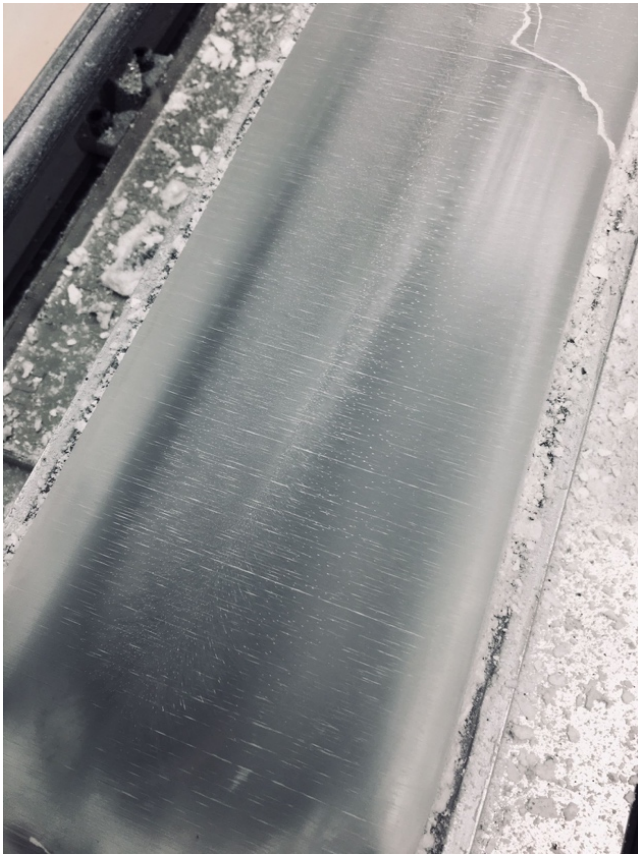


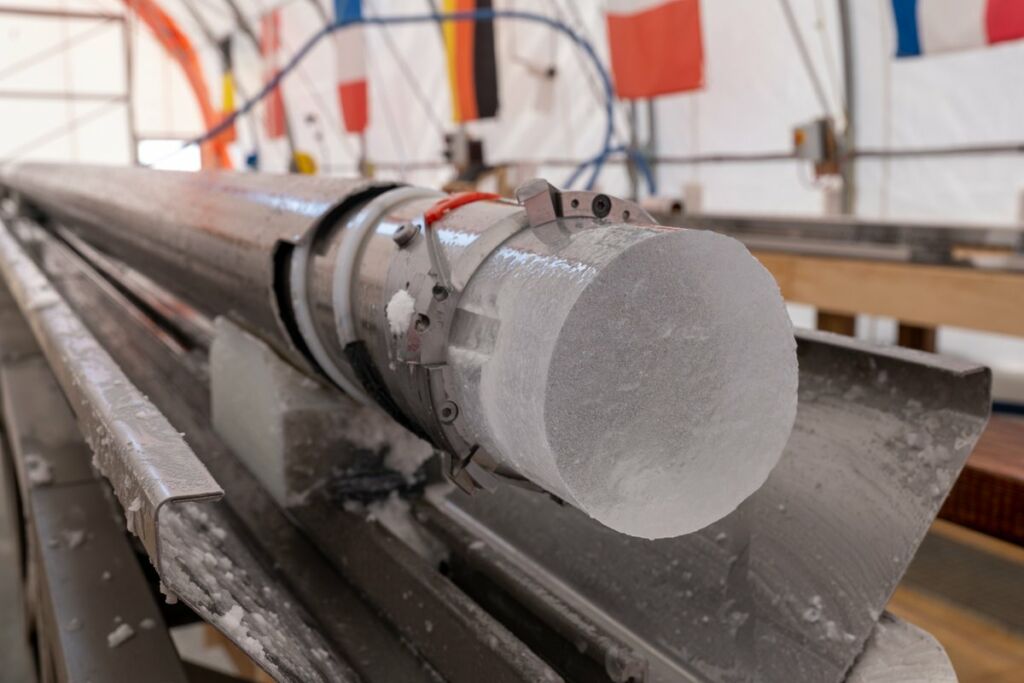
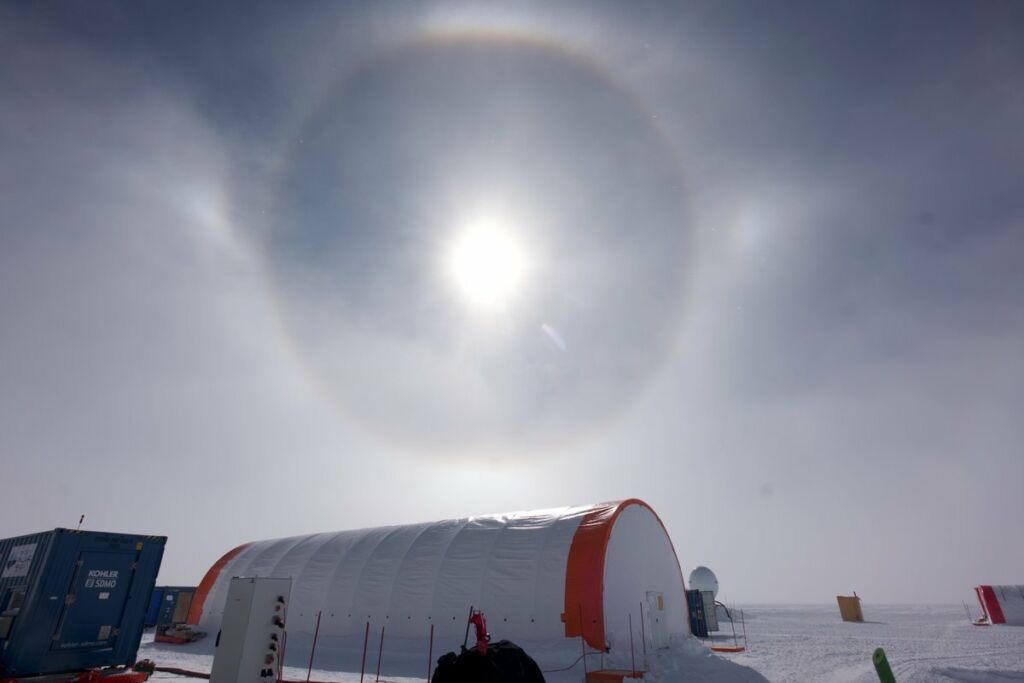
A Treasure Trove of Climate Data
For thousands of years, the snow and ice that covers the Earth’s polar regions has been accumulating, layer by layer, preserving a record of our planet’s climate history as air is trapped in the snow when deposited on the surface. The snow is buried and compressed by layers of snow above, compressing through several stages and eventually becoming dense ice. This process, known as firnification1, constitutes the genesis of glacier ice. The process involves consolidating the fine, freshly fallen snow, which may contain up to 95 per cent air2, into pure ice with minimal or no air content.
In Antarctica, it creates an ice sheet that has an average thickness of 2 kilometres. The thickest ice, however, sits over the Astrolabe Subglacial Basin to the south of the Adélie Coast where it has been measured to be 4,897 metres thick3. Due to its thickness, this ice exerts a tremendous amount of pressure on the underlying rock, causing it to sink and form deep basins that can hold even more ice. The harsh, inhospitable environment of Antarctica with extremely low temperatures and high winds preserves the ice and forms a comprehensive archive of past climate conditions4.
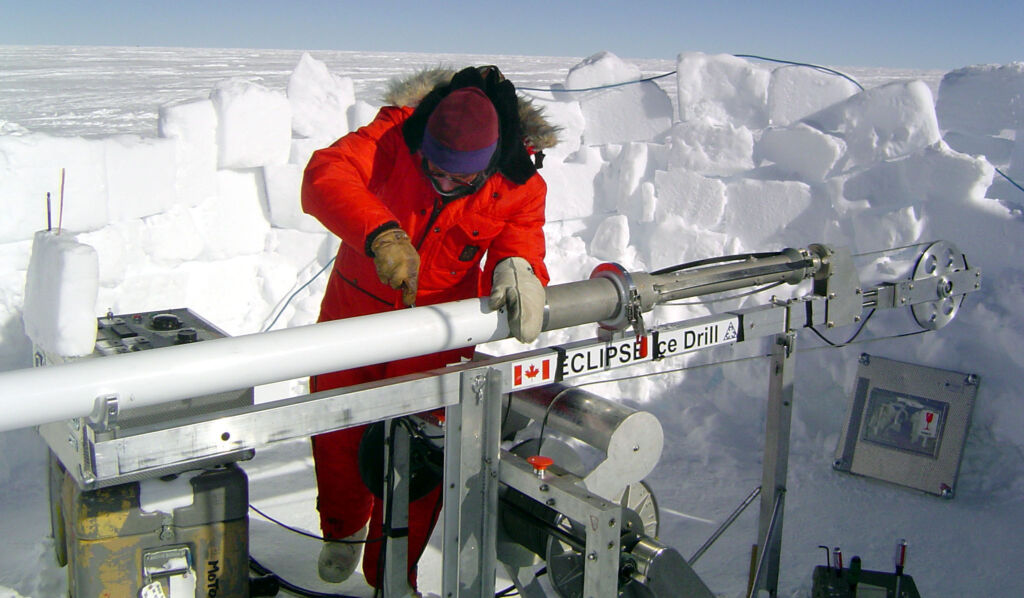
Understanding Earth’s Climate
For decades paleoclimatologists have been coming to the most remote continent to retrieve cylinders of ice that span hundreds of thousands of years of Earth’s climate history5, comparable to vertical tree rings6. By studying these layers, scientists can learn about how the atmosphere was composed at the particular time and at the very spot as well as how our climate has changed over time, what has caused those changes, and what the implications are for the future. Apart from the main greenhouse gases carbon dioxide, methane and nitrous oxide, the ice cores include dust7, which provides information about past atmospheric circulation patterns and volcanic activity, and water isotopes, which can be used to estimate past temperatures.
But how do we know how old each layer of ice is, and what period it represents? Dating ice cores8 is a complex and multi-step process that involves combining multiple methods to create a timeline of past climate events.
One of the simplest ways to date ice cores is by counting annual layers. Snow falls in regular annual cycles in many regions, leaving visible layers in the ice9. Scientists can use visual cues like changes in the texture or colour of the ice to identify annual layers and estimate their age. However, this method is typically only accurate for ice cores dating back a few hundred years.
Radioisotopes are atoms that decay over time, releasing radiation that can be measured10. Scientists can use this property to date ice cores by measuring the concentration of certain radioisotopes in the ice. For example, the isotope oxygen-18 can be used to estimate past temperatures, while the isotope carbon-14 can be used to date organic material in the ice.
Volcanic eruptions leave a distinctive signature in the ice, in the form of ash and other particles. By identifying and dating these layers of volcanic ash, scientists can create a timeline of past volcanic activity and use it to date other layers of ice11.
Ice cores can also be dated by matching them to other records of past climate, such as tree rings or sediment layers. By finding overlapping patterns in these records, scientists can create a timeline of past climate events that can be used to date the ice.
In addition to providing insights into past climate conditions, ice cores can also help us understand how the Earth’s climate system responds to changes in temperature and other environmental factors12. This information is crucial for predicting future climate changes, for developing strategies to mitigate and adapt to climate change, and it underscores the urgent need for action to address this global challenge and is an important tool for policymakers, allowing them to make informed decisions about how to address the ongoing climate crisis.

A Journey Through Time
While most ice cores are continuous and in a tidy chronological order, the oldest one, completed in 2004, only dates back 800,000 years13. Why is that? Well, the ice that is deposited on the surface of Antarctica is constantly being buried and flowing out towards the edges14 of the continent as it moves along the underlying topography under its own weight and induced by gravity, eventually being lost by melting into the ocean or as icebergs calving into the ocean15. As a result, the oldest ice is rare and difficult to find. But scientists are determined to uncover the secrets that lie within this ancient ice, and a new race is underway to drill deeper and retrieve even older ice cores.
In 1966, a team of American scientists led by glaciologist Dr. Charles R. Bentley drilled the first Antarctic ice core at Byrd Station16, which was established as an American research centre in the middle of the West Antarctic ice sheet. The core was named the “Byrd Ice Core”17 in honour of Admiral Richard E. Byrd, who led several explorations to Antarctica. The drilling process took three months to reach a depth of 216 metres, which is roughly the height of a 60-story building.
The Byrd Ice Core was a major milestone in the history of ice core drilling, containing a record of the last 50,000 years of Earth’s climate history. It demonstrated the potential of ice cores to provide a window into Earth’s past climate and inspired further exploration of Antarctica’s ice sheets. Today, ice core drilling continues to be a vital tool in understanding our planet’s climate history and predicting its future. And since 1966, we’ve come a long way.
Scientists estimate that hundreds of ice cores have been collected in Antarctica from various locations and depths18, each offering a glimpse into the planet’s environmental history, and when taken together, they create a detailed record of climate changes spanning millions of years.
Some of the most important ice cores in history include the Siple Dome core with its deepest ice recovered from 974 m at a site between the Kamb and Bindschadler Ice Streams and an age of 97,600 years19. The core was retrieved during three summer season campaigns between 1996 and 1999 and was drilled to bedrock at 1,004 metres depth20. It yielded some intriguing and enigmatic results that have piqued the interest of scientists worldwide. One of its most notable findings is the peculiar changes in water isotopes during the deglacial period21, which cannot be easily explained. Experts believe these anomalies might indicate a rapid decrease in the elevation of the surrounding ice streams or contain valuable information about the Earth’s atmospheric carbon dioxide levels22 during that period.
Another famous ice core is the Russian project site at Vostok. Drilling began already in the 1950s and work at the fifth Vostok core began in 1990. 17 years later, the drill reached 3,661 metres, recovering the deepest core ever obtained23, and was extended to 3,769 metres in 2012. The estimated age of the ice is 420,000 years at 3,310 m depth while it is difficult to interpret the data reliably below that point because of mixing of the ice. The Vostok ice core was the first to cover a full glacial-interglacial cycle.
The European ice core collaboration EPICA started drilling a core at Dome C in 1996. Despite facing harsh conditions and technical challenges, the team made remarkable progress, reaching a depth of 2,871 metres in just two seasons of drilling. But the real test lay ahead, as they worked tirelessly for another four years to reach the bedrock at 3,260 metres. What they found was truly astounding. The Dome C core contained a wealth of data that could unlock the mysteries of our planet’s climate history. And because of the low accumulation rates of ice at this site, the record extended far back in time – all the way to 800,000 years ago. For the scientists involved in this groundbreaking project, the results were nothing short of exhilarating. But the implications of their findings could have far-reaching consequences for our understanding of the past, present, and future of our planet.

In 2006, a team of intrepid scientists embarked on a daring mission to explore the depths of the West Antarctic Ice Sheet. With funding from the National Science Foundation, they began drilling deep into the ice using a special tool called the Deep Ice Sheet Coring (DISC) drill, developed and operated by the Ice Drilling Design and Operations group at the University of Wisconsin, Madison. Over the next five years, the team of the West Antarctic Ice Sheet Divide ice core project worked tirelessly, battling extreme weather conditions and technical challenges to reach a depth of 3,405 metres – over two miles down. And what they found there was truly remarkable. The ice at the bottom of the hole fell as snow 67,748 years ago. As the site has high snow accumulation, the ice only extends back 62,000 years, but as a consequence, the core provides the highest resolution data for the period it covers of all ice cores. To determine the precise age of the core, the team used two different dating methods. By counting annual layers, they were able to date the top of the core to an age of 31,200 years ago24. Stratigraphic methods were used to date the bottom of the core to 67,748 years ago25. These precise dating methods enabled the team to gain a better understanding of the causes of past climate changes. And with the last 50 metres of ice left in place to protect the pristine aqueous basal environment26, this incredible core stands as a testament to the ingenuity and determination of the human spirit.

The Oldest Climate Archive so far
“The ability to measure atmospheric composition directly is one of the biggest advantages of ice cores. That’s why people spend years and years in the most isolated places getting them.”
– Yuzhen Yan, Postdoctoral Research Associate, Rice University
In 2015, a team embarked on a groundbreaking mission to retrieve cores from the Allan Hills. In a quest to delve deeper into the Earth’s history, a team of intrepid scientists set their sights on a unique target: “blue ice.”27 Located near the surface in the Allan Hills region of Antarctica, these ancient ice flows are known for exhuming some of the oldest ice from the depths below. The campaign in the Allan Hills Blue Ice Area recovered of clean, ancient, bubbly ice that extend as far back as 2.7 million years, by far the oldest polar ice samples yet recovered28.
How could they top the previous record by 1.7 million years? The region of the Allan Hills Blue Ice Area, a group of hills at the end of the Transantarctic Mountains System, located in Oates Land and Victoria Land in East Antarctica, is renowned for the flow of old ice along the rising bedrock and its proximity to the surface. This upwelling along the underlying bedrock topography surfaces astonishingly old ice. Though stratigraphically disturbed29, the cores provided clean, ancient, bubbly ice that contained crucial information about the Earth’s climate. The area has been of particular interest to scientists when they started finding lunar and Martian meteorites30 that came down to Earth a long time ago.

Driven up from below by the shifting ice layers and exposed by relentless winds that strip away snow and younger ice, these blue ice patches are a tantalising treasure trove of ancient climate data31. In 2015, a team led by Princeton University geochemist and principal investigator of the project, John Higgins, set out to excavate the motherlode. Their mission was a resounding success, as they retrieved a record-setting core that would unlock secrets from the distant past. As they extracted each core, the team knew they were on the brink of a historic discovery. And they were right. The cores were dated using potassium-argon dating, revealing ice from a mind-boggling 2.7 million years ago32 – the oldest yet found in a core33.
The presence of greenhouse gases in the bubbles34 trapped in the ice from Earth’s atmosphere at a time when the planet’s cycles of glacial advance and retreat were just beginning35 and suddenly doubled in length36 could provide valuable insights into the factors that triggered the ice ages37. The fact that the oldest ice is part of a single unreplicated sample underlines the uniqueness of it, which is the only surviving fragment of the ancient Earth’s atmosphere, renders it extremely valuable.


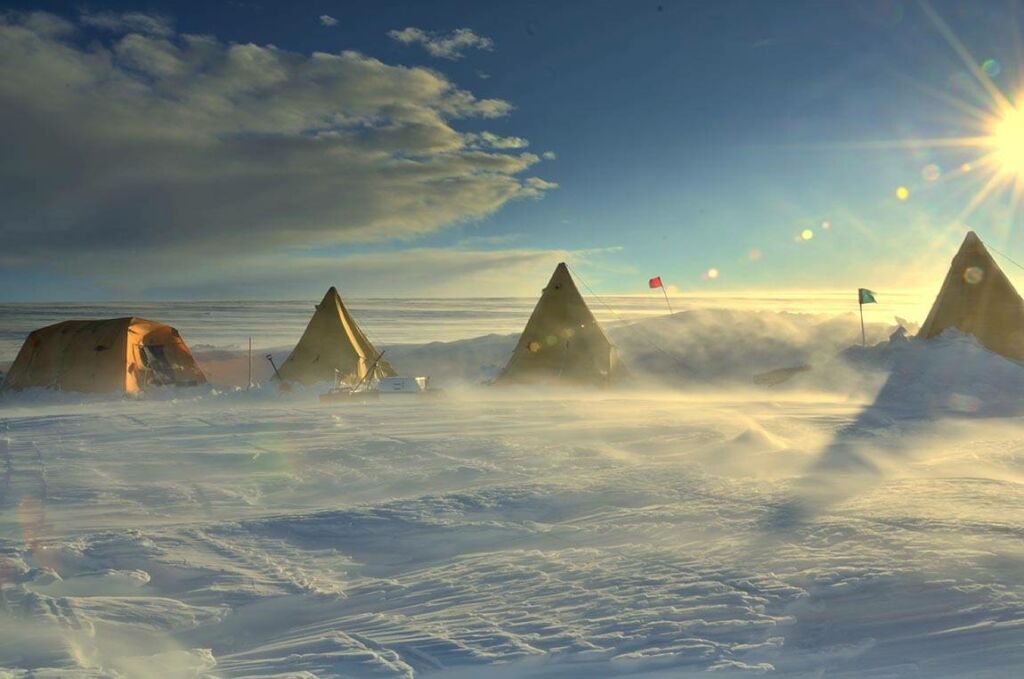

However, as the sample was separated from the rest of the ice of its timeline, there is, unfortunately, a limit to the data it can provide about the atmospheric conditions. Because of these limitations, it is unlikely to definitively resolve the debate surrounding the transition between ice ages. And while continuous ice cores provide us with a detailed record of climate changes over hundreds of thousands of years, allowing us to see how climate patterns have evolved over time, the Allan Hill ice core on the other hand offers a unique snapshot of the past. It give us a glimpse into much longer periods, allowing us to study the climate history of our planet on a much larger scale. Despite its limited scope, the successful retrieval of such ancient ice samples remains an impressive feat. Nevertheless, the data obtained from the core are being used to fine-tune other indirect methods for measuring ancient levels of carbon dioxide, such as analysing isotopic changes in fossils of single-celled foraminifera. As these methods have become more refined, their estimates have consistently aligned with the recent findings from the core. This serves as a great validation of the accuracy of these proxy methods.
The Race for the Oldest Ice
And there might be even older ice out there38. This 2022-2023 austral summer season, a team of the multi-institution Center for Oldest Ice Exploration led by Sarah Shackleton and John Higgins continued work at the site at Allan Hills to find ice maybe as old as five million years. As ancient ice samples contain valuable information about the Earth’s atmosphere and its composition, it can help scientists to understand how the planet has changed over time, what has caused ice ages to start and to end, and thus gives us a better possibility to project how Earth might change in the future.
Shackleton and Higgins are not alone, as scientists from around the world are engaged in what seems to be a “friendly” race to extract the oldest ice from Antarctica. In fact, many of the scientists involved in these projects collaborate and share data and resources with one another. Of particular interest is ice from some three million years back when temperatures on Earth were about two to three degrees Celsius warmer and sea levels were about 20 metres higher than today. Looking at the atmosphere’s composition this could give a better understanding of how much temperatures may rise in the future which is particularly interesting to answer the question how much warmer it will get as we continue to pump CO2 into our atmosphere.
One of the most prominent projects is the European Project for Ice Coring in Antarctica (EPICA), which began in the late 1990s. EPICA has already retrieved ice cores that are over 800,000 years old from the Antarctic ice sheet, but the team is now looking for even older ice. The follow-up project, called Beyond EPICA-Oldest Ice, is led by French and Italian scientists and plans to drill a new borehole just 40 km away from the Concordia Station at a site called Little Dome C, 3,230 metres above sea level, in East Antarctica, where they hope to find ice that is over 2 million years old39. “We believe this ice core will give us information on the climate of the past and on the greenhouse gases that were in the atmosphere during the Mid-Pleistocene Transition (MPT), which happened between 900,000 and 1.2 million years ago,” said team-leader Carlo Barbante, the director of the Institute of Polar Sciences of the National Research Council of Italy. “During this transition, climate periodicity between ice ages changed from 41,000 to 100,000 years: the reason why this happened is the mystery we hope to solve.”40. The team plans to use a variety of techniques, including radar imaging and ice flow modelling, to identify the best locations to drill and will use a specialised drill that can extract longer and more intact ice cores than traditional drills. The team also plans to use sophisticated analysis techniques, such as DNA sequencing and laser spectroscopy, to study the ice cores and uncover new information about the Earth’s past climate. End of January 2023, the team reached an important milestone and successfully completed the first ice core drilling campaign at a depth of 808 metres.
Only five kilometres away from the European drilling site, the Australian Antarctic Division is making camp for their Million Year Ice Core41 project. To do so, the Australian team is mastering an incredible logistical challenge42 and traverses the East Antarctic Ice Sheet43 from the coastal Casey Station to the inland camp at the drilling site with five modified tractors pulling a mobile station on sleds – and back. Across previously untravelled icy terrain, the expedition faced some serious weather that tested the capabilities of their tractor trains and traversing skills, including blizzards, temperatures dropping to -44°C, and hardened snow dunes, called sastrugi. Travelling at around 10 km/h the focus of progress is safety, not speed The site was selected after a thorough evaluation and research process where radar surveys of the surrounding area have shown that the MYIC site sits on top of a topographic high ridge but far enough away from the Beyond EPICA site – separated by a valley – for independent records from these two sites.44
Even though, the aim for this season was only to forge as much of the path as possible and put the speciality travelling equipment to the test45, the team was already able to drill a total of 18 shallow cores, each about 12 metres long and containing about 200 years old ice, from the site at Little Dome C. For the Australian Antarctic Division this extraordinary scientific quest with a 2,300 kilometres round trip of 10 researchers opens a new chapter to its Antarctic climate research.
There are also efforts supported by institutes in China, Japan and South Korea that are also looking for ancient ice46, if not necessarily the oldest ever recovered. China has recently emerged as a major player in the field of Antarctic ice core drillings and has undertaken a series of ambitious projects to drill deep into the Antarctic ice. In January 2017, China made a major breakthrough in Antarctic ice core drilling by successfully retrieving an 800.8 metre long ice core from the Dome Argus (also called Dome A), the highest point on the East Antarctic Ice Sheet. Some 800 kilometres away, the Japanese National Institute of Polar Research is conducting their drills at different sites at Dome Fuji. Their teams have conducted deep drilling twice at the Dome Fuji station, reaching a depth of 3,035 metres in 200747 that has produced ice cores covering 720,000 years48. Japan’s third deep core drilling expedition aims now to bore down to about 2,735 metres at another site 5 kilometres south-southwest from the Dome Fuji station to extract the world’s oldest ice which is expected to take until 202849.
Each team brings its own unique strengths and approaches to the table, and the hope is that by working together, they can achieve their common goal more quickly and efficiently. Each project has its own strengths and specificities, and it is likely that they will all contribute to better understanding our planet’s climate history. ◀
Relevant Curiously Polar Episodes


References
[1] ‘Snow’, Nature, vol. 139, 186-187, 30 January 1937.
[2] NSIDC, ‘Why Snow Matters’, National Snow and Ice Data Center, 29 July 2022, https://nsidc.org/learn/parts-cryosphere/snow/why-snow-matters, (accessed 8 March 2023).
[3] P. Fretwell et al., ‘Bedmap2: Improved ice bed, surface and thickness datasets for Antarctica’, The Cryosphere, vol. 7, Issue 1, 28 February 2013.
[4] NSF, ‘About Ice Cores’, National Science Foundation – Ice Core Facility, 19 June 2013, https://icecores.org/about-ice-cores, (accessed 13 March 2023).
[5] National Geographic Society, Paleoclimatology’, National Geographic, 22 October 2022, https://education.nationalgeographic.org/resource/paleoclimatology-RL/, (accessed 13 March 2023)
[6] Jan French, ‘Frozen in Time: Ice Cores’, 22 January 2003.
[7] Peter Rejcek, ‘Blown Past: Dust Found in Antarctic Ice Cores Offers Clues to Ancient Climate’, The Antarctic Sun, 24 April 2014, https://icecores.org/indepth/spring-2014/blown-past-dust-found-antarctic-ice-cores-offers-clues-ancient-climate, (accessed 13 March 2023).
[8] Australian Antarctic Program, ‘Dating A Core’, Australian Antarctic Division, 25 July 2020, https://www.antarctica.gov.au/about-antarctica/weather-and-climate/climate-change/ice-cores/dating-a-core/, (accessed 13 March 2023).
[9] McGwire, K., McConnell, J., Alley, R., Banta, J., Hargreaves, G., & Taylor, K. (2008). Dating annual layers of a shallow Antarctic ice core with an optical scanner. Journal of Glaciology, 54(188), 831-838.
[10] Sigl, M., Jenk, T., Kellerhals, T., Szidat, S., Gäggeler, H., Wacker, L., Synal, H.-A., Boutron, C., Barbante, C., Gabrieli, J., Schwikowski, M. (2009). Towards radiocarbon dating of ice cores. Journal of Glaciology, 55(194), 985-996.
[11] Nelia W. Dunbar, ‘Tephra Record in Antarctic Ice Cores’, New Mexico Bureau of Geology & Mineral Resources, 4 May 2022, https://geoinfo.nmt.edu/staff/dunbar/research/ice_cores.html, (accessed 13 March 2023).
[12] Jessica Stoller-Conrad, ‘Core questions: An introduction to ice cores’, NASA’s Jet Propulsion Laboratory, 14 August 2017, https://climate.nasa.gov/news/2616/core-questions-an-introduction-to-ice-cores/, (accessed 13 March 2023).
[13] Thomas Bauska, ‘Ice cores and climate change’, British Antarctic Survey, 30 June 2022, https://www.bas.ac.uk/data/our-data/publication/ice-cores-and-climate-change/, (accessed 13 March 2023).
[14] Holli Riebeek, ‘First Map of Antarctica’s Moving Ice’, NASA Earth Observatory, 18 August 2011, https://earthobservatory.nasa.gov/images/51781/first-map-of-antarcticas-moving-ice, (accessed 13 March 2023).
[15] Laura Nesser, ‘Introduction to Earth Sciences, 14. Glaciers’, Pressbooks at Virgina Tech, 2 July 20221, https://pressbooks.lib.vt.edu/introearthscience/chapter/glaciers-v2/, (accessed 13 March 2023).
[16] Ueda, H. T. (2007). Byrd Station drilling 1966–69. Annals of Glaciology, 47, 24-27.
[17] Jouzel, J. (2013). A brief history of ice core science over the last 50 yr. Climate of the Past, 9(6), 2525–2547.
[18] Raynaud, D., Parrenin, F. (2009). Ice Cores, Antarctica And Greenland. In: Gornitz, V. (eds) Encyclopedia of Paleoclimatology and Ancient Environments. Encyclopedia of Earth Sciences Series. Springer, Dordrecht.
[19] Brook, E. J., White, J. W., Schilla, A. S., Bender, M. L., Barnett, B., Severinghaus, J. P., Taylor, K. C., Alley, R. B. & Steig, E. J. (2005). Timing of millennial-scale climate change at Siple Dome, West Antarctica, during the last glacial period. Quaternary Science Reviews, 24(12), 1333-1343.
[20] NSF, Ice Core Facility ‘Siple Dome’, National Science Foundation, 30 September 2020, https://icecores.org/inventory/siple-dome, (accessed 12 March 2023).
[21] Taylor, K. C., White, J. W. C., Severinghaus, J. P., Brook, E. J., Mayewski, P. A., Alley, R. B., Steig, E.J., Spencer, M.K., Meyerson, E., Meese, D.A., Lamorey, G. W., Grachev, A., Gow, A. J., & Barnett, B. A. (2004). Abrupt climate change around 22ka on the Siple Coast of Antarctica. Quaternary Science Reviews, 23(1), 7-15.
[22] Ahn, J., Wahlen, M., Deck, B. L., Brook, E. J., Mayewski, P. A., Taylor, K. C., & White, J. W. (2004). A record of atmospheric CO2 during the last 40,000 years from the Siple Dome, Antarctica ice core. Journal of Geophysical Research: Atmospheres, 109(D13).
[23] Jouzel, J. (2013). A brief history of ice core science over the last 50 yr. Climate of the Past, 9(6), 2525–2547.
[24] Sigl, M., Ferris, D., Fudge, T.J., Winstrup, M., Cole-Dai, J., McConnell, J.R., Taylor, K.C., Welten, K.C., Woodruff, T.E., Adolphi, F., Brook, E.J., Bisiaux, M., Buizert, C., Caffee, M.W., Dunbar, N., Edwards, R., Geng, L., Iverson, N., Koffman, B., Layman, L., Maselli, O.J., McGwire, K., Muscheler, R., Nishiizumi, K., Pasteris, D.R., Rhodes, R.H. and Sowers, T.A. (2016) The WAIS Divide deep ice core WD2014 chronology – Part 2: Annual-layer counting (0-31 ka BP); Climate of the Past, 12, p. 769 – 786
[25] Buizert, C., Cuffey, K.M., Severinghaus, J.P., Baggenstos, D., Fudge, T.J., Steig, E.J., Markle, B.R., Winstrup, M., Rhodes, R.H., Brook, E.J., Sowers, T.A., Clow, G.D., Cheng, H., Edwards, R.L., Sigl, M., McConnell, J.R. and Taylor, K.C. (2015) The WAIS Divide deep ice core WD2014 chronology – Part 1: Methane synchronization (68-31 ka BP) and the gas age-ice age difference; Climate of the Past, 11, p. 153 – 173
[26] Morse, D.L., Blankenship, D.D., Waddington, E.D. and Neumann, T.A. (2002) A site for deep ice coring in West Antarctica: Results from aerogeophysical surveys and thermal-kinematic modeling; Annals of Glaciology, 35, p. 36 – 44
[27] Climate Change Institute, ‘Glaciology of Blue Ice Areas in Antarctica’, University of Maine, http://www2.umaine.edu/climatechange/Research/projects/blueice.html, (accessed 12 March 2023).
[28] Yan Y., Ng J., Higgins J., Kurbatov A., Clifford H., Spaulding N., & Bender M. L., 2.7-million-year-old ice from Allan Hills blue ice areas, East Antarctica reveals climate snapshots since early Pleistocene. Goldschmidt Abstracts. 2017;4359.
[29] Kehrl, L., Conway, H., Holschuh, N., Campbell, S., Kurbatov, A. V., & Spaulding, N. E. (2018). Evaluating the duration and continuity of potential climate records from the Allan Hills Blue Ice Area, East Antarctica. Geophysical Research Letters, 45, 4096– 4104.
[30] Peter Dockrill, ‘Scientists Say They’ve solved The Mystery of Antarctica’s Missing Iron Meteorites’, Science Alert, 18 February 2016, https://www.sciencealert.com/iron-meteorites-in-antarctica-could-be-hiding-just-centimetres-below-the-icy-surface, (accessed 12 March 2023).
[31] Yan, Y., Bender, M. L., Brook, E. J., Clifford H. M., Kemeny P. C., Kurbatov, A. V., Mackay, S., Mayewski, P. A., Ng, J., Severinghaus, J. P., & Higgins, J. A., Two-million-year-old snapshots of atmospheric gases from Antarctic ice. Nature 574, 663–666 (2019).
[32] Bob Yirka, ‘2.7-million-year-old ice core pulled from Antarctica’, Phys.org, 21 August 2017, https://phys.org/news/2017-08-million-year-old-ice-core-antarctica.html, (accessed 12 March 2023).
[33] Voosen, P. (2017) 2.7-million-year-old ice opens window on past; Science 357, 6352, pp. 530-631.
[34] Yan, Y., Bender, M. L., Brook, E. J., Clifford, H. M., Kemeny, P. C., Kurbatov, A. V., Mackay, S., Mayewski, P. A., Ng, J., Severinghaus, J. P., Higgins, J. A. (2019) Two-million-year-old snapshots of atmospheric gases from Antarctic ice. Nature 574, 663-666
[35] Paul Voosen, ‘Record-shattering 2.7-million-year-old-ice core reveals start of the ice ages’, Science, 15 August 2017, https://www.science.org/content/article/record-shattering-27-million-year-old-ice-core-reveals-start-ice-ages, (accessed 12 March 2023).
[36] Morgan Kelly, ‘Two million-year-old ice cores provide first direct observation of an ancient climate’, Princeton Environmental Institute, 21 November 2019, https://www.princeton.edu/news/2019/11/21/two-million-year-old-ice-cores-provide-first-direct-observations-ancient-climate, (accessed 12 March 2023).
[37] Paul Voosen, “World’s oldest ice core could solve mystery of ‘flipped’ ice cycles’, Science, 30 October 2019, https://www.science.org/content/article/world-s-oldest-ice-core-could-solve-mystery-flipped-ice-age-cycles, (accessed 12 March 2023).
[38] Birgit Katz, ‘Scientists Find Record 2.7-Million-Year-Old Ice Core in Antarctica’, Smithsonian Magazine, 18 August 2017, https://www.smithsonianmag.com/smart-news/scientists-find-27-million-year-old-ice-core-antarctica-180964566/, (accessed 12 March 2023).
[39] Chung, A. et al., ‘Stagnant ice and age modelling in the Dome C region, Antarctica’, EGUsphere, Preprint repository (23 February 2023)
[40] Jonathan Amos, ‘Quest begins to drill Antarctica’s oldest ice’, BBC News, 30 November 2021, https://www.bbc.com/news/science-environment-59475410, (accessed 13 March 2023)
[41] Australian Antarctic Program, ‘Million Year Ice Core’, Australian Antarctic Division, 23 December 2022, https://www.antarctica.gov.au/science/climate-processes-and-change/antarctic-palaeoclimate/million-year-ice-core/, (accessed 13 March 2023).
[42] Australian Antarctic Program, ‘Australia’s Modern Inland Traverse’, Australian Antarctic Division, 15 February 2023, https://www.antarctica.gov.au/science/climate-processes-and-change/antarctic-palaeoclimate/inland-traverse/, (accessed 13 March 2023).
[43] Jo Chandler, ‘The million year ice project: the quest to find the oldest ice on Earth’, The Guardian, 26 August 2022, https://www.theguardian.com/world/2022/aug/27/the-million-year-ice-project-the-quest-to-find-the-oldest-ice-on-earth, (accessed 13 March 2023).
[44] Roberts, J. et al., ‘Site selection for Australia’s Million Year Ice Core Project’, IPICS International Partnership in Ice Core Sciences, 3rd Open Science Conference – Ice Core Science at the three Poles, Abstract ID : 238
[45] Tanya Plibersek, ‘Australia’s million-year ice core quest departs Casey Station in Antarctica’, Media Release of the Minister for the Environment and Water, Commonwealth of Australia, 31 December 2022, https://minister.dcceew.gov.au/node/2510, (accessed 13 March 2023).
[46] Chelsea Harbvey, ‘Climate heartbeat: Scientists hunt for the world’s oldest ice’, E&E News Climate Wire, 23 November 2022, https://www.eenews.net/articles/climate-heartbeat-scientists-hunt-for-worlds-oldest-ice/, (accessed 13 March 2023).
[47] The Japan News, ‘Japanese expedition team plans to extract ‘world’s oldest ice’ in Antarctica’, The Japan News by The Yomiuri Shimbun, 19 December 2022, https://japannews.yomiuri.co.jp/science-nature/science/20221219-78258/, (accessed 13 March 2023).
[48] Kumiko Goto-Azuma, ‘Uncovering the history of climate change from ice cores’, National Institute of Polar Research – Ice Core Research Center, 17 November 2020, https://www.nipr.ac.jp/english/collaborative_research/icecore.html, (accessed 13 March 2023).
[49] The Japan News, ‘Japanese expedition team plans to extract ‘world’s oldest ice’ in Antarctica’, The Japan News by The Yomiuri Shimbun, 19 December 2022, https://japannews.yomiuri.co.jp/science-nature/science/20221219-78258/, (accessed 13 March 2023).
Citation: Henry Páll Wulff, ‘Drilling Through Time: The Thrilling Pursuit of the Oldest Antarctic Ice‘, henrypall.com, 13 March 2023, https://henrypall.com/2023/03/13/drilling-through-time/
Published: 13 March 2023
